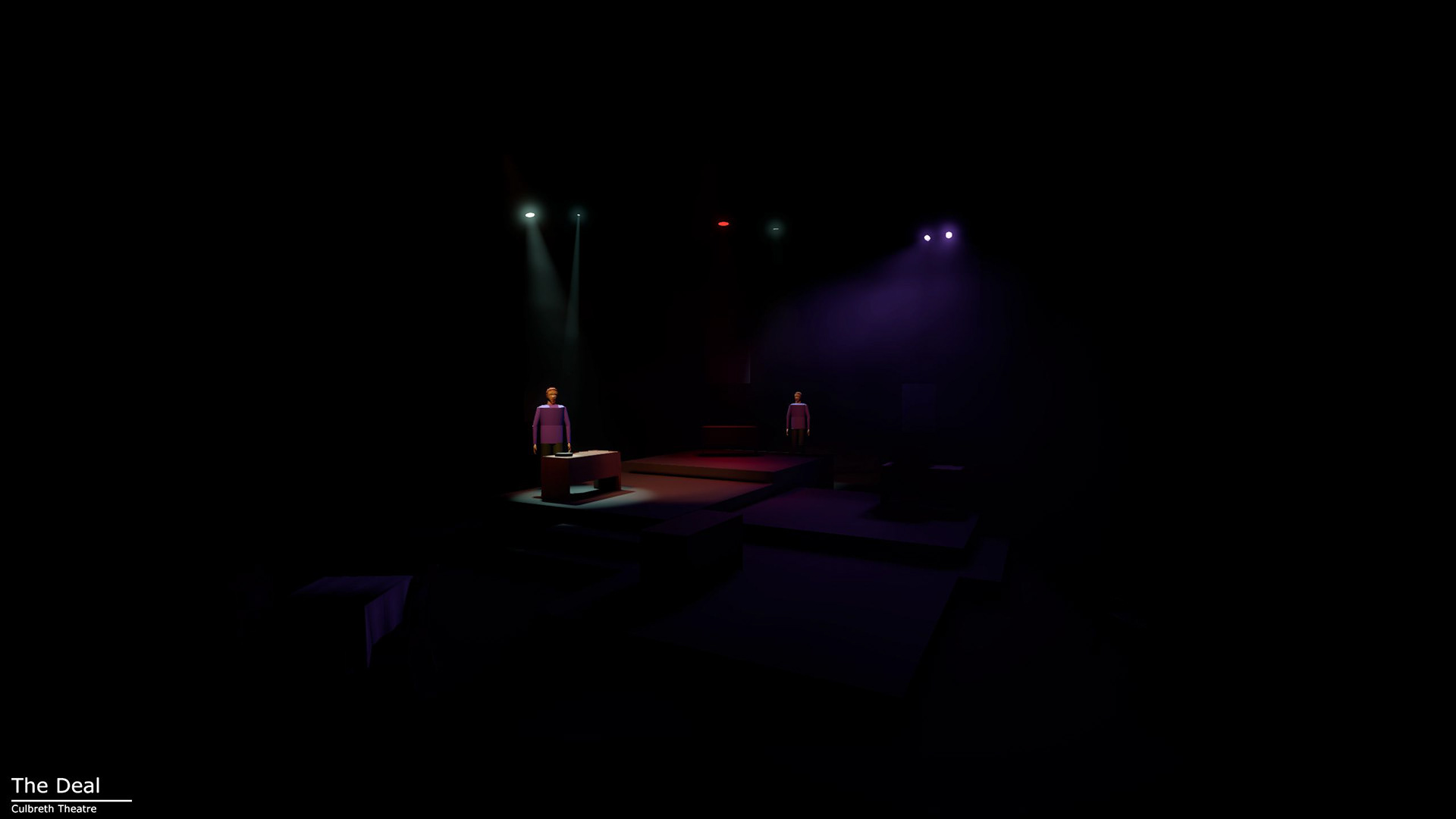A proof-of-concept restaging of Matt Witten's drama, The Deal. This was an exercise in script analysis, scenic, lighting, and production design. Set in University of Virginia's Culbreth theatre, my vision of the set would feature four platforms representing the offices of each of the play's four characters. Scenes would take place on and around these platforms and lean on lighting to create a sense of unity and separation for various moments.
GOALS
- Gain experience set building in SketchUp
- Import a scenic model from SketchUp into Capture
- Design a proof of concept rig using capture within the Culbreth space
- Create mock paperwork using Lightwright
PROCESS
Because I have produced and lit the show before, I did little script research for my "preproduction" phase. I began my design process by creating the scenic elements. Using a model of the Culbreth stage, I designed a four platform cascading stage that accommodated each of the four characters and their offices. Non-office settings were pushed off of the platforms SL and SR, for instance the restaurant and park.
Scenic design rendered in SketchUp
Unshaded wireframe view of theatre and rigged lights
Once scenic dimensions were finalized, I created and scaled masking around sight lines knowing roughly how big I wanted acting areas to be and how I wanted them lit. Using actual line set measurements from theater schematics, I was able to trim my electrics and estimate where my lights would go. Once this data was complete, I was able to import everything into Capture to begin virtually hanging and focusing lights.
Inside the virtual rig, I am able to place lights wherever I need, focus them with just a click, and easily make shutter adjustments, adjust zoom, and drop color. I went system by system, first starting with front light, then high cross lights, back lights, top lights, gobo systems, and specials.
Full rig in Capture with ambient lighting turned on to see fixtures
The US platform front light system
Creating even top light that could shutter to the square platforms was tricky, especially on upstage platforms. Trying to achieve even coverage of squares, while also keeping unwanted light off of other platforms, minimizing overall spill, and making sure the light angle was flattering enough for a front light was very challenging.
Once I was happy with how my systems, booms, and specials were looking, I quantized light measurements so that lights were positioned at nice rounded measurements, usually multiples of 3" on the pipe. Overlaps necessitated rearrangement of lights and refocusing, which became a self-sustaining cycle of imperfection until I exhausted myself.
Top view of the plot
Next, I decided color and frost for every fixture in the rig. Systems tended to get similar frost and color for evenness.
I went with a subtle warm lavender for the front light - R51 - as a nice middle ground to bring out the tones I would expect from the set, costumes, and skin in these offices. As a straight play, The Deal doesn't ask too much from its lighting. The front light wanted to be even, flattering, and nothing special.
High cross light had a very subtle cool and warm side for variety to highlight the figures on my platforms. I wanted something on the low end of the saturation scale to pop actors out of the black brick upstage.
Back light found itself being cooler then the cool cross light, mainly to again help pop actors out of the predominantly warm tones found behind them, namely the wood grain and warm front lighting.
I doubled up a par downlight to have a red and blue primary, allowing me to cover a sizable range of color and tone. This was particularly important as I wanted emotion and tension to move and breath about the set even when characters hadn't reached their offices. These systems give me the freedom to manipulate color and shadow more acutely than my more subtle lights.
Some oddball features include window lights and gobos to simulate sun shining through, shin light booms, typically found in dance plots, and back stage washes. I included books because I wanted the flexibility to catch people but not the floor they stood on, more for dramatic effect and to get into the heads of characters and step out of the person-in-a-space visual and into person-out-of-their-head visual. Back washes (which look more like blinders) are made up of amber and purple sides-back-cross lights and were a way to splash really vibrant color all over the set for aesthetic.
Part of the design process also included channeling my systems and specials. This took many iterations until it settled into something that made sense in my brain. After channeling, I could create a virtual magic sheet inside of ETC Eos to control my Capture rig.
Part of the EOS magic sheet
To cap off this project, I created several looks, scenes, and presets and rendered them out so I had something to show for all this work. Treating this like an actual show, I also did all* of the necessary paperwork for the design, including plots and a channel hookup.
*definitely not all of the required paperwork for a show
RENDERS







